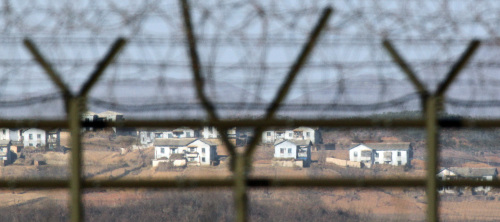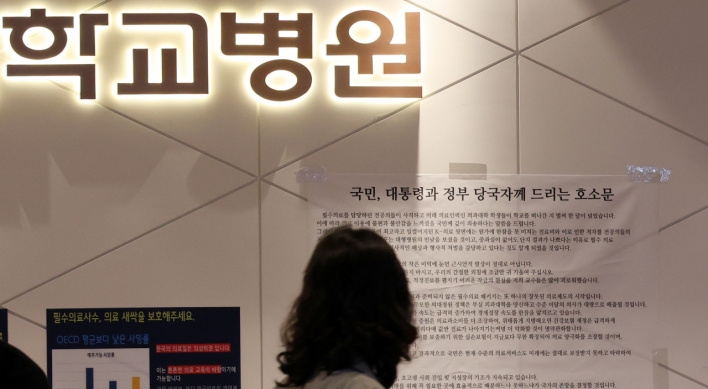A presidential panel on defense advancement plans to suggest developing the Marine Corps into a “national strategic task force” carrying out missions, including in case of a sudden change in North Korea, a government source said Friday.
“Currently, the missions for Marine troops are protecting the western side of Seoul and the border islands in the West Sea along with amphibious landing operations. But the committee will make a recommendation (to the president) for revising such missions,” said the source, who did not wish to be identified.
“While serving as ‘prompt response troops,’ the Marine troops will take on a number of missions including a multi-purpose mobile striking mission in case of a sudden change or instability in North Korea.”
Calls have been mounting for enhancing the Marine Corps stationed on the five border islands in the West Sea since the Nov. 23 artillery shelling of Yeonpyeong Island, which killed four South Koreans including two civilians.
The committee also plans to suggest reviving an incentive system giving extra scores in recruitment exams to those who have fulfilled their military duty as part of measures to boost morale in the military.
The system was abolished in 1999 after the Constitutional Court ruled against it with critics arguing that it was unfair and discriminatory for women and disabled men.
The committee will recommend to President Lee Myung-bak the 69 tasks for defense reform next week, the source said.

The committee also plans to suggest putting the term of mandatory military service back to 24 months.
Under the plan announced in 2007 by the former Roh Moo-hyun government, the military is to reduce the service term to 18 months by 2014. But some military officials and security experts have been calling for the plan to be scrapped, citing military threats from North Korea and an expected troop shortage caused by the low birthrate.
The committee also plans to suggest the establishment of a combined military command to better protect the five vulnerable islands near the tense western sea border.
Meanwhile, the North Korean military has deployed some 100 additional multiple launch rocket systems in its installations, posing more threats to South Koreans in the Seoul metropolitan area within their striking range, a government source said Friday.
It has also established an automated air defense system to strengthen its capabilities to intercept hostile aircraft, according to the source.
The increased deployment of its combat equipment comes as the North has ratcheted up peninsular tensions with a series of military provocations including the Nov. 23 artillery shelling.
“The North has recently increased the number of its multiple launch rocket systems from 5,100 to 5,200. They can launch a concentrated ambush attack from their current bases on Seoul and its neighboring areas,” the source said, refusing to be identified.
The source also said that the North has deployed some 200 more tanks to some of the frontline units under its mechanized corps.
“The North has developed and deployed new tanks, which imitated the T-72 tank (the main battle tank designed by the former Soviet Union). The new tanks have replaced the old ones, which have been sent to and are now operated by rear units,” he said.
The source also said that the North’s special warfare unit is comprised of seven divisions and 25 brigades. The number of the North’s special warfare troops is estimated at around 200,000.
The military believes that the North may continue to develop new tactics involving its asymmetric weapons such as submarines equipped with high-powered torpedoes so as to attack more advanced South Korean warships, according to the source.
The new air defense system has allowed the North to reduce the time for it to intercept hostile aircraft and enhance the accuracy for its interception operations, the source said.
Amid heightened tensions, the North has also deployed SA-3 surface-to-air missiles with a range of 13 kilometers in Pyongyang and other major military facilities, and SA-2 missiles with a range of 47 kilometers and SA-5 missiles with a range of 260 kilometers in areas near the Military Demarcation Line and its coastal regions.
Such information on the North Korean military will be included in the South’s defense whitepaper, which will be published later this month.
The defense whitepaper was initially planned to be published in early November, but its publication has been postponed to include the recent artillery attack on the border island.
“We are still reviewing the North Korean military capacity. So the content could be included or change. Taking all that into account, we are seeking to publish the whitepaper by the end of this month,” said Kim Min-seok, spokesman for the Ministry of National Defense in a press briefing.
By Song Sang-ho (sshluck@heraldcorp.com)
“Currently, the missions for Marine troops are protecting the western side of Seoul and the border islands in the West Sea along with amphibious landing operations. But the committee will make a recommendation (to the president) for revising such missions,” said the source, who did not wish to be identified.
“While serving as ‘prompt response troops,’ the Marine troops will take on a number of missions including a multi-purpose mobile striking mission in case of a sudden change or instability in North Korea.”
Calls have been mounting for enhancing the Marine Corps stationed on the five border islands in the West Sea since the Nov. 23 artillery shelling of Yeonpyeong Island, which killed four South Koreans including two civilians.
The committee also plans to suggest reviving an incentive system giving extra scores in recruitment exams to those who have fulfilled their military duty as part of measures to boost morale in the military.
The system was abolished in 1999 after the Constitutional Court ruled against it with critics arguing that it was unfair and discriminatory for women and disabled men.
The committee will recommend to President Lee Myung-bak the 69 tasks for defense reform next week, the source said.

The committee also plans to suggest putting the term of mandatory military service back to 24 months.
Under the plan announced in 2007 by the former Roh Moo-hyun government, the military is to reduce the service term to 18 months by 2014. But some military officials and security experts have been calling for the plan to be scrapped, citing military threats from North Korea and an expected troop shortage caused by the low birthrate.
The committee also plans to suggest the establishment of a combined military command to better protect the five vulnerable islands near the tense western sea border.
Meanwhile, the North Korean military has deployed some 100 additional multiple launch rocket systems in its installations, posing more threats to South Koreans in the Seoul metropolitan area within their striking range, a government source said Friday.
It has also established an automated air defense system to strengthen its capabilities to intercept hostile aircraft, according to the source.
The increased deployment of its combat equipment comes as the North has ratcheted up peninsular tensions with a series of military provocations including the Nov. 23 artillery shelling.
“The North has recently increased the number of its multiple launch rocket systems from 5,100 to 5,200. They can launch a concentrated ambush attack from their current bases on Seoul and its neighboring areas,” the source said, refusing to be identified.
The source also said that the North has deployed some 200 more tanks to some of the frontline units under its mechanized corps.
“The North has developed and deployed new tanks, which imitated the T-72 tank (the main battle tank designed by the former Soviet Union). The new tanks have replaced the old ones, which have been sent to and are now operated by rear units,” he said.
The source also said that the North’s special warfare unit is comprised of seven divisions and 25 brigades. The number of the North’s special warfare troops is estimated at around 200,000.
The military believes that the North may continue to develop new tactics involving its asymmetric weapons such as submarines equipped with high-powered torpedoes so as to attack more advanced South Korean warships, according to the source.
The new air defense system has allowed the North to reduce the time for it to intercept hostile aircraft and enhance the accuracy for its interception operations, the source said.
Amid heightened tensions, the North has also deployed SA-3 surface-to-air missiles with a range of 13 kilometers in Pyongyang and other major military facilities, and SA-2 missiles with a range of 47 kilometers and SA-5 missiles with a range of 260 kilometers in areas near the Military Demarcation Line and its coastal regions.
Such information on the North Korean military will be included in the South’s defense whitepaper, which will be published later this month.
The defense whitepaper was initially planned to be published in early November, but its publication has been postponed to include the recent artillery attack on the border island.
“We are still reviewing the North Korean military capacity. So the content could be included or change. Taking all that into account, we are seeking to publish the whitepaper by the end of this month,” said Kim Min-seok, spokesman for the Ministry of National Defense in a press briefing.
By Song Sang-ho (sshluck@heraldcorp.com)



![[Herald Interview] 'Amid aging population, Korea to invite more young professionals from overseas'](http://res.heraldm.com/phpwas/restmb_idxmake.php?idx=644&simg=/content/image/2024/04/24/20240424050844_0.jpg&u=20240424200058)














![[Today’s K-pop] Kep1er to disband after 2 1/2 years: report](http://res.heraldm.com/phpwas/restmb_idxmake.php?idx=642&simg=/content/image/2024/04/25/20240425050792_0.jpg&u=)